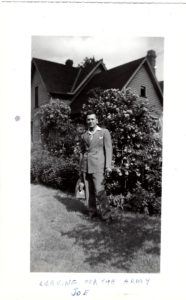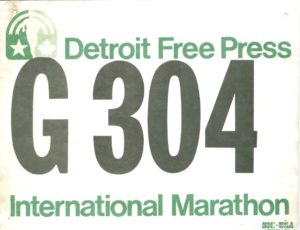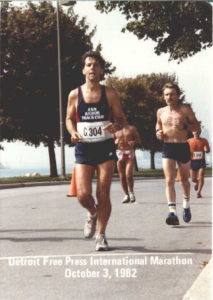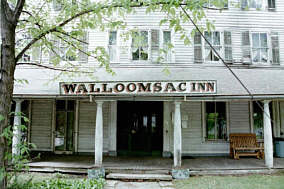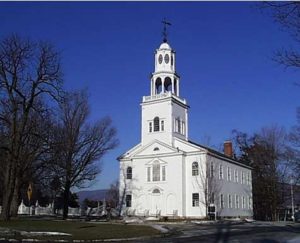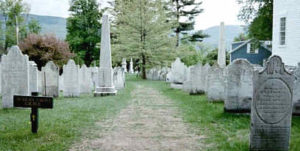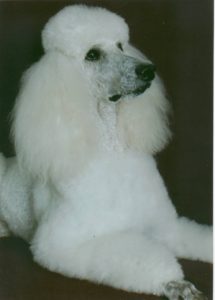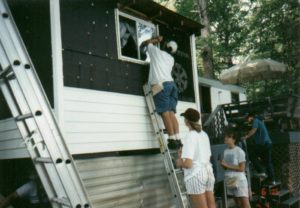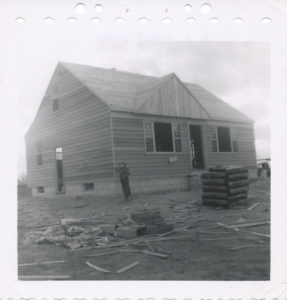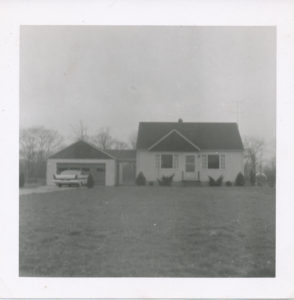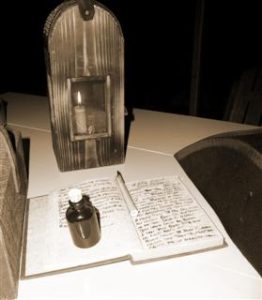Did you ever wonder where your faith comes from? The question really never meant much to me until one evening, when I was trying to organize my thoughts about my mother. She had just passed away, and I was to give a “tribute” at her graveside services. Quickly, I found that my thoughts were not centered on some heavy religious doctrine taught to me in my youth. Instead, I found myself reminiscing about the great family stories.
Both my grandmother and grandfather came to the United States from Lithuania. My grandmother came here because she heard the United States was a wonderful place, and my grandfather came to avoid the draft during the Prussian War. I only met my grandfather once, for about five minutes in a hospital; he was ill and dying of cancer. My grandfather chose to abandon his wife and two daughters, taking his son and moving to another city. In a desperate attempt to survive, my grandmother sent her two daughters back to Lithuania to grow up on a relative’s farm near Kaunas. Many years later, as young adults, my mother and her sister would return to the U.S. to continue their lives.
 My life was spent listening to the many stories about Lithuania, life on the farm, and the tragic stories of the country’s takeover by the Communists. Those stories included my mother’s long walks down the country roads into town and how she and her sister would stop at each of the many crosses along the way to pray. In each of those stories, whether about farm life or the distant relatives I would never know, there was always a sense of pride. With my father’s parents both coming from Lithuania too, it was easy for me to grow up with my own sense of ancestral interest.
My life was spent listening to the many stories about Lithuania, life on the farm, and the tragic stories of the country’s takeover by the Communists. Those stories included my mother’s long walks down the country roads into town and how she and her sister would stop at each of the many crosses along the way to pray. In each of those stories, whether about farm life or the distant relatives I would never know, there was always a sense of pride. With my father’s parents both coming from Lithuania too, it was easy for me to grow up with my own sense of ancestral interest.
There was one very defining story, however, that seemed to open the window to my soul. In Lithuania, there is a place called “The Hill of Crosses,” located 12 kilometers north of the small industrial city of Siauliai. Standing upon a small hill are many hundreds of thousands of crosses that represent Christian devotion and a memorial to Lithuanian national identity.
The city of Siauliai was founded in 1236 and occupied by Teutonic Knights during the 14th century. The tradition of placing crosses dates from this period and probably first arose as a symbol of Lithuanian defiance of foreign invaders. Since the medieval period, the Hill of Crosses has represented the peaceful resistance of the Lithuanian faith to oppression. In 1795, Siauliai was incorporated into Russia but returned to Lithuania in 1918. Many crosses were erected upon the hill after the peasant uprising of 1831-63. By 1895, there were at least 150 large crosses; in 1914, there were 200 crosses; and by 1940, there were 400 large crosses surrounded by thousands of smaller ones. While Kaunas was not close to Sialuliai, it was easy to see how my mother would have been influenced by these symbols of faith that were so prevalent throughout Lithuanian society.
 Captured by Germany in World War II, the city suffered heavy damage when Soviet Russia retook it at the war’s end. From 1944 until Lithuania’s independence in 1991, Siauliai was a part of the Lithuanian Soviet Socialist Republic of the USSR. During the Soviet era, the pilgrimage to the Hill of Crosses served as a vital expression of Lithuanian nationalism. The Soviets repeatedly removed Christian crosses placed on the hill by Lithuanians. Three times, during 1961, 1973, and 1975, the hill was leveled, the crosses were burned or turned into scrap metal, and the area was covered with waste and sewage. Following each of these desecrations, local inhabitants and pilgrims from all over Lithuania rapidly replaced crosses on the sacred hill. In 1985, the Hill of Crosses was finally left in peace. The reputation of the sacred hill has since spread all over the world, and every year it is visited by many thousands of pilgrims. Pope John Paul II visited the Hill of Crosses in September 1993.
Captured by Germany in World War II, the city suffered heavy damage when Soviet Russia retook it at the war’s end. From 1944 until Lithuania’s independence in 1991, Siauliai was a part of the Lithuanian Soviet Socialist Republic of the USSR. During the Soviet era, the pilgrimage to the Hill of Crosses served as a vital expression of Lithuanian nationalism. The Soviets repeatedly removed Christian crosses placed on the hill by Lithuanians. Three times, during 1961, 1973, and 1975, the hill was leveled, the crosses were burned or turned into scrap metal, and the area was covered with waste and sewage. Following each of these desecrations, local inhabitants and pilgrims from all over Lithuania rapidly replaced crosses on the sacred hill. In 1985, the Hill of Crosses was finally left in peace. The reputation of the sacred hill has since spread all over the world, and every year it is visited by many thousands of pilgrims. Pope John Paul II visited the Hill of Crosses in September 1993.
The size and variety of crosses is as amazing as their numbers. Beautifully carved out of wood or sculpted from metal, the crosses range from three meters tall to the countless tiny examples hanging profusely upon the larger crosses. An hour spent on the sacred hill will reveal crosses brought by Christian pilgrims from all around the world. Rosaries, pictures of Jesus and the saints, and photographs of Lithuanian patriots also decorate the larger crosses. On windy days, breezes blowing through the forest of crosses and hanging rosaries is said to produce uniquely beautiful music. This rich history was part of my nationality, passed on by the subtle stories by my mother and grandparents. A Lithuanian-style cross could always be found on the wall in any of my relatives homes.
As I began to think deeply about my mother’s influence, I came to recognize that in her life, she had learned the gift of simplicity. She had every worldly reason to reject God’s love. Abandoned as a child and sent away across the sea, my mother’s youth was to live almost as an indentured farmhand in Lithuania. Upon returning to the United States, she labored as a servant for a wealthy family. During my birth, she suffered serious medical problems and was soon forced to share her husband with the US Army. I cannot imagine watching my father leave only four weeks after I was born, not to see him again for three years.
My mother never drove an automobile. She had no career. My mother left no worldly legacy. Her focus was always on just serving her family. Her faith was, as Jesus says in Matthew 18:3, “faith like a child’s.” Its simplicity was its perfection. My mother trusted in Jesus because it was a worthy truth. In her years of life, I never heard her utter a distrusting word about God. She could not quote you Scripture but she did not have to. She just believed it because it was true. In today’s world, that is a rare claim, to have asked nothing of God accept to serve Him. Even in her later years, they were filled with pain, never a distrusting word.
 As I lay to rest, the ashes of my mother next to those of my father, all of their dreams, all they had accumulated in life, all of their goals, and all of their accomplishments were now to be measured in how well her family understood her simple faith, the faith of a child. I do not know how my mother passed her faith on to me, but she did, and I will eternally thank her. They call my parent’s generation the “Greatest Generation.” And now I know why. Despite hardship, war, and constant sacrifice, they still knew and loved God. With all the abundance of my generation and the generation of my children, our greatest prayer must be to simply say one day, “We knew God and we love Him.” My challenge now is to recognize the “crosses by the roadside,” stopping in reverence and prayer. God is everywhere, but unless we stop, we miss the simplicity of His gift of salvation.
As I lay to rest, the ashes of my mother next to those of my father, all of their dreams, all they had accumulated in life, all of their goals, and all of their accomplishments were now to be measured in how well her family understood her simple faith, the faith of a child. I do not know how my mother passed her faith on to me, but she did, and I will eternally thank her. They call my parent’s generation the “Greatest Generation.” And now I know why. Despite hardship, war, and constant sacrifice, they still knew and loved God. With all the abundance of my generation and the generation of my children, our greatest prayer must be to simply say one day, “We knew God and we love Him.” My challenge now is to recognize the “crosses by the roadside,” stopping in reverence and prayer. God is everywhere, but unless we stop, we miss the simplicity of His gift of salvation.
